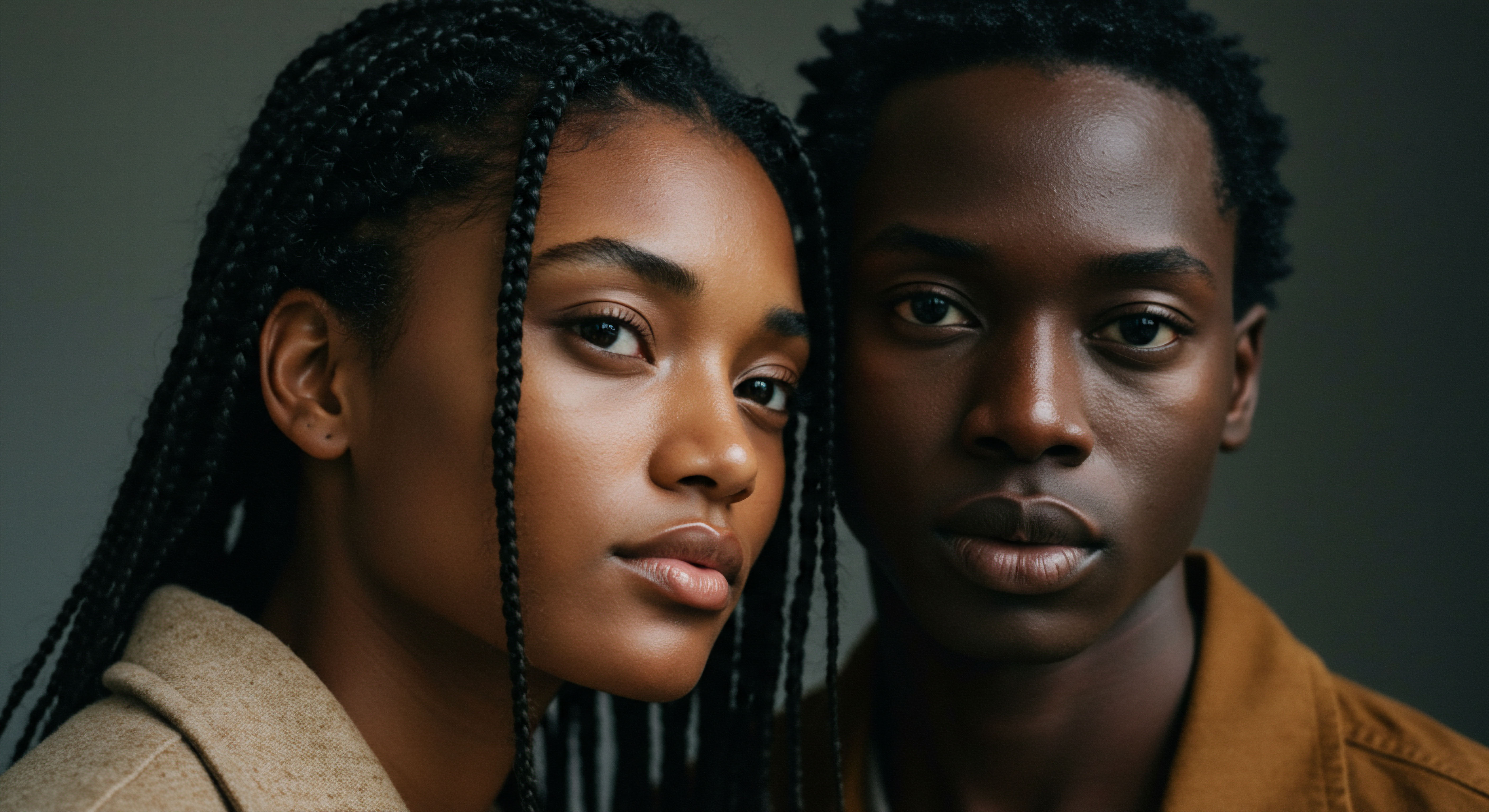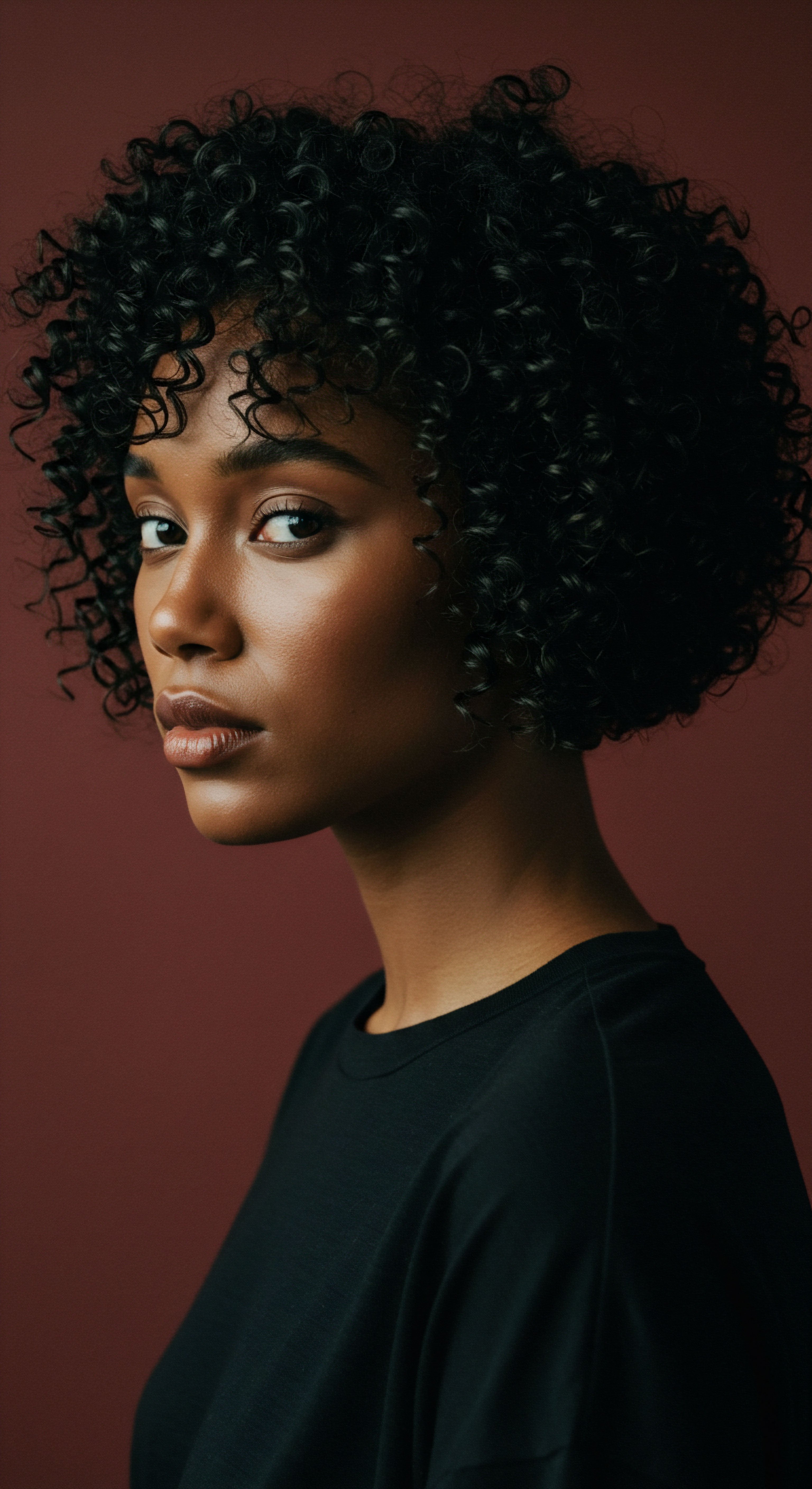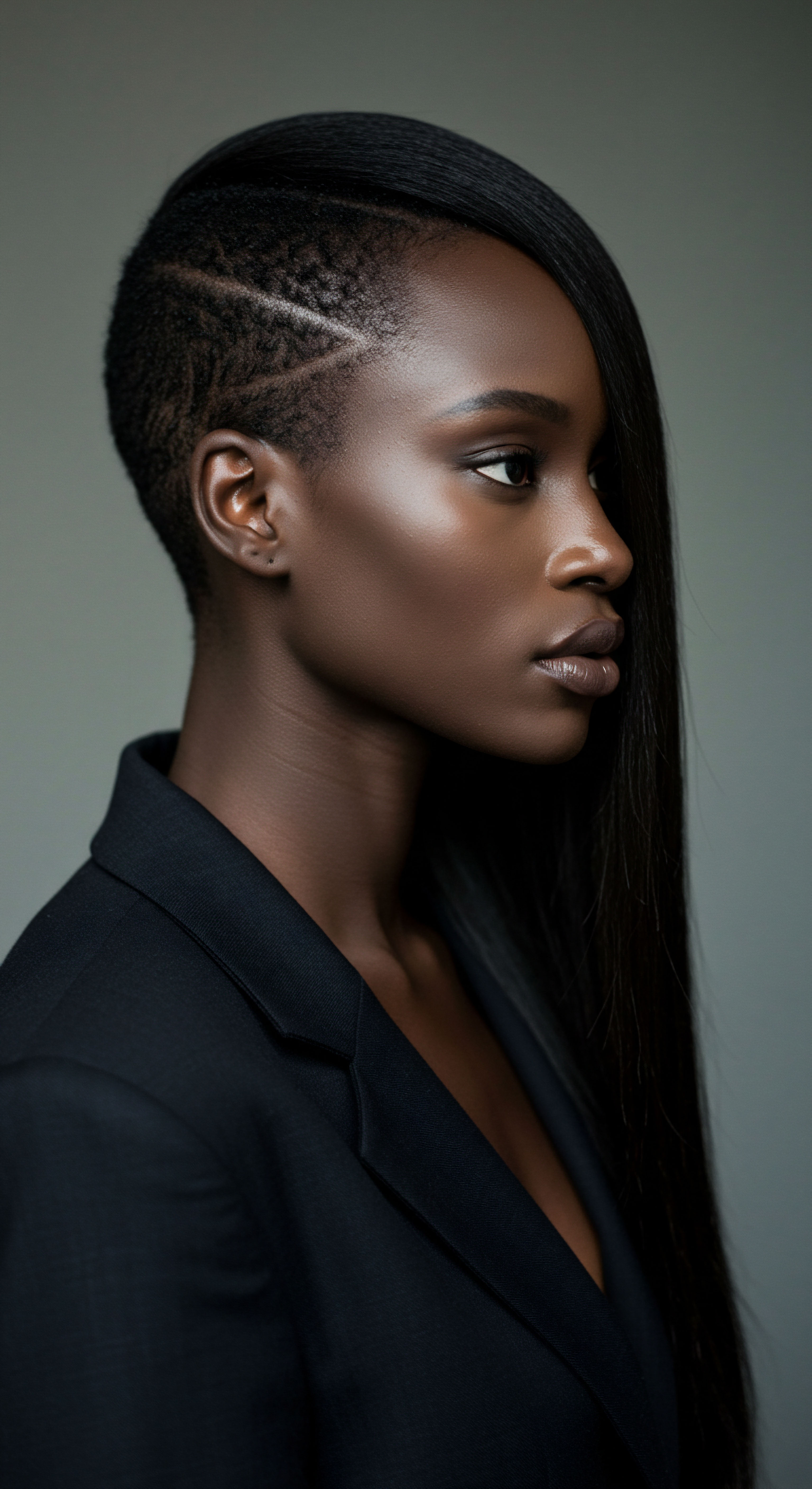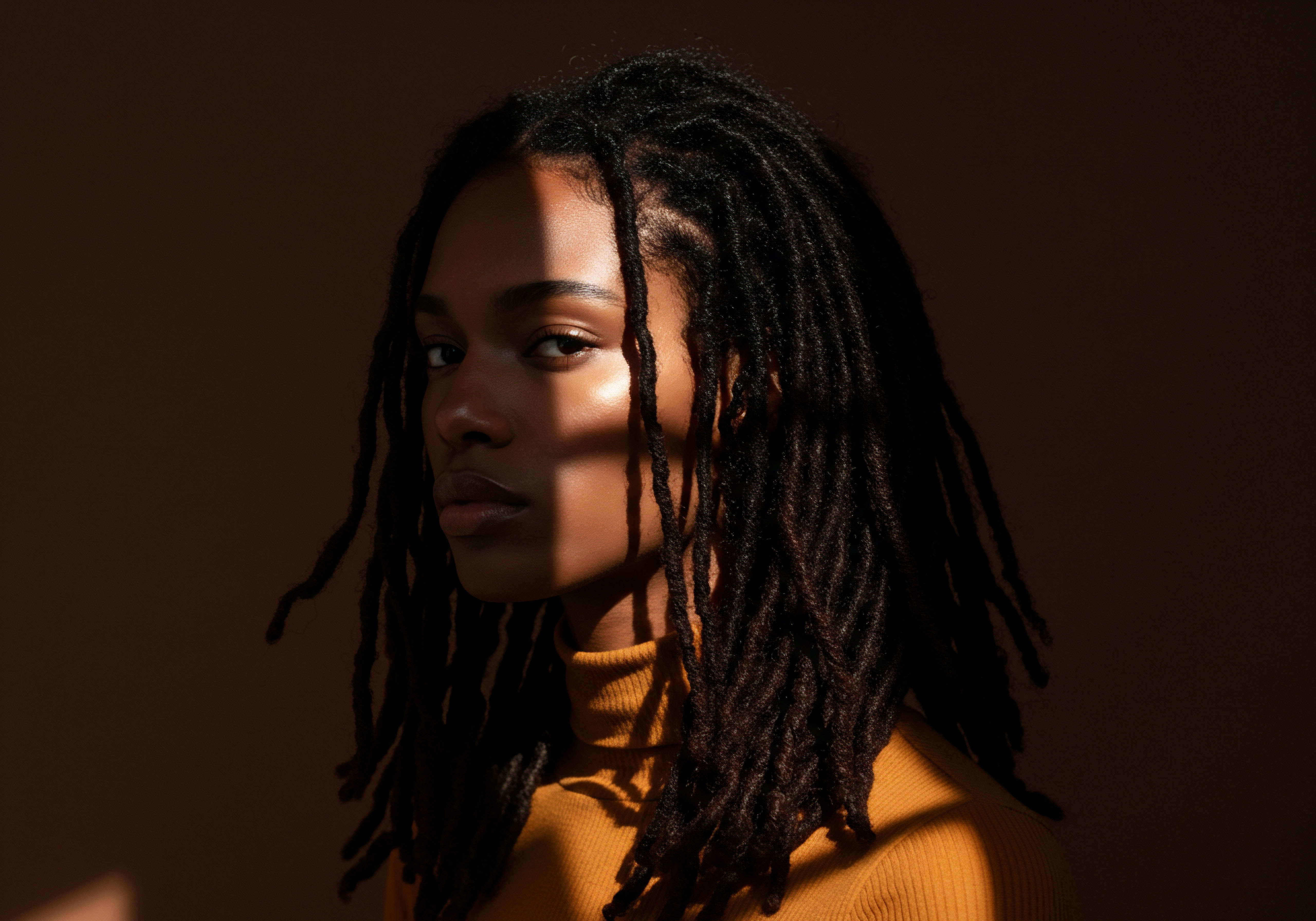
Roots
Have you ever held a single strand of hair, perhaps your own, and truly observed its path? The way it coils, bends, or undulates, even when detached from the scalp, holds a quiet wisdom. It is a testament to an unseen world, a whisper from the very core of our being. This visible expression of shape, so often admired and celebrated, is not a matter of chance or fleeting whim.
Instead, it is a deeply rooted story, told through the intricate dance of biology and cellular artistry. To truly appreciate the unique contours of textured hair, we must first descend into its foundational anatomy, to the hidden architects that grant each strand its singular form.
The journey begins not on the surface, but beneath the skin, within the remarkable structure known as the Hair Follicle. For those with textured hair, this follicle is far from a straight, cylindrical tube. Instead, it exhibits a pronounced curvature, often described as an S-shape or a spiral. This distinct bend in the follicle dictates the direction of hair growth, causing the emerging strand to curve and coil from its very inception.
Consider it the mold, shaping the hair fiber as it ascends, layer by layer, into the world. The deeper the curve of the follicle, the tighter the curl or coil that manifests. This fundamental anatomical difference is a primary determinant of the hair’s final appearance.
The hidden architecture of the hair follicle is the primary sculptor of a strand’s distinct curl or coil.

Hair’s Inner Workings
Beyond the follicle’s shape, the hair shaft itself possesses an internal arrangement that contributes significantly to its form. The hair fiber is composed of three main layers ❉ the outermost Cuticle, the central Cortex, and sometimes a innermost Medulla.
- Cuticle ❉ This protective outer layer consists of overlapping, scale-like cells. In straight hair, these scales lie relatively flat, but in textured hair, their arrangement can be more lifted or irregular, contributing to its unique feel and how it interacts with moisture.
- Cortex ❉ Forming the bulk of the hair fiber, the cortex is packed with protein bundles, primarily alpha-keratins. These proteins are organized into intermediate filaments, which provide mechanical support. The distribution and packing of these keratin proteins within the cortex are not always symmetrical in textured hair. An uneven distribution of these protein building blocks can lead to differential growth rates on opposing sides of the hair shaft, compelling it to curve.
- Medulla ❉ This central core, often absent in finer hair strands, is a loosely arranged region. While its role in curl formation is less direct than the follicle or cortex, it contributes to hair’s volume and elasticity.
Chemical bonds within the hair also play a critical role in maintaining its shape. Among these, Disulfide Bonds are the strongest, forming between cysteine residues in the keratin proteins. These bonds are responsible for the hair’s enduring structure and its ability to hold a specific shape.
Textured hair, particularly Afro-textured hair, exhibits a higher density of these disulfide bonds, which further stabilizes its unique coiling and kinking patterns. Weaker bonds, such as hydrogen bonds and salt bonds, also contribute to the hair’s flexibility and how it responds to water and styling, temporarily influencing its shape.

What Does Follicle Asymmetry Tell Us About Hair’s Curvature?
The elliptical cross-sectional shape of textured hair strands, a direct result of the curved follicle, is a key anatomical feature. While straight hair typically emerges from a round follicle and has a circular cross-section, textured hair often has an oval or even flattened cross-section. This flattened shape, coupled with the follicle’s curvature, creates an inherent instability that encourages the hair to coil.
Imagine a ribbon ❉ a flat ribbon naturally curls when twisted, whereas a round cord does not. Similarly, the flat nature of textured hair strands, combined with their origin from a curved pathway, predisposes them to spiral.
Beyond the macro-level of the follicle, the cellular processes within the follicle itself exhibit a subtle asymmetry. Research suggests that an uneven proliferation of cells in the mitotic zone around the dermal papilla within the follicle contributes to the hair’s curl. This means that cells on one side of the hair follicle might grow at a slightly different rate than those on the other, forcing the hair shaft to bend as it forms. This microscopic cellular dance, unseen by the eye, is a quiet force in sculpting the hair’s final form.
| Component Follicle Shape |
| Description The tube-like structure from which hair grows. |
| Contribution to Shape A curved or S-shaped follicle directly molds the hair into coils and kinks. |
| Component Hair Shaft Cross-Section |
| Description The shape of a hair strand when cut horizontally. |
| Contribution to Shape Elliptical or flattened cross-sections encourage coiling due to inherent instability. |
| Component Keratin Distribution |
| Description The arrangement of proteins within the cortex. |
| Contribution to Shape Asymmetrical distribution of keratin causes differential growth, leading to bends. |
| Component Disulfide Bonds |
| Description Strong chemical links between keratin proteins. |
| Contribution to Shape Higher density in textured hair stabilizes and maintains its unique coiling patterns. |

Ritual
Each morning, as light spills into our spaces, a gentle practice unfolds for many ❉ the quiet tending of textured strands. It is a moment of connection, a silent conversation with our hair that extends beyond mere appearance. This daily interaction, these deliberate gestures, hold a special weight when it comes to the unique shapes of textured hair.
While biology lays the foundation, the intentional care and styling choices we make each day act as a profound dialogue with our hair’s inherent nature, coaxing out its best expression and safeguarding its delicate form. Understanding the ‘what’ and ‘how’ of these rituals is not just about product application; it is about honoring the hair’s predisposition and guiding it towards its most vibrant self.
The styling of textured hair is an art form, a practical application of understanding its structure. Techniques such as twists, braids, and Bantu knots are not simply aesthetic choices; they are methods that work in concert with the hair’s natural tendencies. These practices help to define and maintain the curl pattern, reducing tangles and protecting the delicate strands from environmental stressors.
When hair is twisted or braided, its inherent coil is encouraged to align and hold its shape, often leading to more uniform and lasting definition. This deliberate shaping, performed while the hair is often damp and receptive, allows the strands to dry in a desired configuration, enhancing the natural curl.
Daily care and styling choices act as a profound dialogue with hair’s inherent nature, coaxing out its best expression.

What Daily Gestures Preserve Hair’s Intrinsic Form?
Hydration stands as a pillar in the care of textured hair. Due to its unique structure and lifted cuticle, textured hair can experience moisture loss more readily than straighter hair types. This tendency towards dryness can lead to frizz and a loss of curl definition, obscuring the hair’s true shape. Therefore, consistent and gentle hydration is not just about softness; it is a critical act in preserving the integrity of the coil.
Applying water-based products, followed by emollients and sealants, helps to replenish and lock in moisture, allowing the hair to maintain its elasticity and spring. When hair is adequately hydrated, its disulfide bonds remain flexible, permitting the curls to form and reform without undue stress.
Proper detangling is another essential ritual. The natural coiling of textured hair can cause strands to interlock, creating knots and tangles. Attempting to force a comb through dry, matted hair can lead to breakage, compromising the hair’s overall health and altering its natural shape over time.
Using a wide-tooth comb or fingers, starting from the ends and working upwards, on wet or damp hair coated with a slippery conditioner, allows for gentle separation of strands. This methodical approach respects the hair’s delicate nature, minimizing damage and preserving its natural curl pattern.

Tools That Support Shape
The tools employed in textured hair care are extensions of our hands, designed to respect and enhance its unique characteristics.
- Wide-Tooth Combs ❉ These are fundamental for detangling. Their broad spacing prevents excessive pulling and breakage, allowing coils to separate gently without disrupting their structure.
- Denman Brushes or Similar Defining Brushes ❉ These tools, with their strategically placed bristles, can be used to clump curls together, enhancing definition and creating more uniform patterns. The tension created by these brushes, when used on wet hair, helps to activate and smooth the natural curl.
- Microfiber Towels or Old T-Shirts ❉ Unlike traditional terry cloth towels, which can rough up the cuticle and promote frizz, these softer materials absorb excess water without disturbing the curl pattern, helping to maintain definition as the hair dries.
Heat styling, while offering versatility, demands a safety-first approach. High heat can temporarily alter the hair’s disulfide bonds, straightening the curl. While this can be reversed, repeated or excessive heat can cause lasting damage, weakening the hair’s internal structure and potentially leading to a permanent loss of curl elasticity.
When heat is used, protective products and low temperatures are essential to minimize disruption to the hair’s natural shape. The careful selection and application of tools, alongside thoughtful technique, ensures that styling becomes an act of preservation, celebrating the hair’s innate beauty rather than compromising it.

Relay
To truly comprehend the unique contours of textured hair, we must transcend the purely anatomical and the merely practical. We are invited to consider the interplay of biological predispositions with the rich tapestry of human experience, cultural practices, and even the subtle, yet profound, influence of societal currents. How does the whisper of ancestry combine with the daily rituals and the very air we breathe to sculpt our strands? This deeper inquiry reveals that hair’s shape is not a static decree, but a dynamic expression, shaped by forces both seen and unseen.

Beyond Biology How Do Cultural Echoes Shape Our Strands?
The science of hair shape, while rooted in genetics and cellular biology, gains a profound layer of understanding when viewed through an anthropological lens. Cultural practices, passed down through generations, often serve as practical responses to the inherent properties of textured hair. For instance, traditional protective styles such as cornrows, twists, and locs, prevalent across African diasporic communities, are not merely aesthetic statements.
They are ingenious methods developed over centuries to manage, protect, and maintain hair that is naturally prone to tangling and breakage due to its coiled structure and elliptical cross-section. These styles minimize manipulation, retain moisture, and shield the hair from environmental damage, thereby preserving its health and intrinsic shape.
The perception and care of textured hair are also shaped by historical narratives and beauty standards. For generations, in many societies, straight hair was held as the ideal, leading to practices that chemically or thermally altered textured hair. This historical context highlights how external pressures can influence the relationship individuals have with their natural hair shape.
Today, a powerful reclamation of natural hair is underway, a movement that celebrates the inherent beauty and versatility of coils, curls, and kinks. This shift is not only a matter of personal style; it is a cultural reaffirmation of identity, rejecting imposed ideals in favor of self-acceptance and the celebration of natural form.
Hair’s shape is a dynamic expression, sculpted by biology, culture, and the currents of society.

Hair’s Microscopic Vulnerabilities and Strengths
While the unique shape of textured hair is undeniably beautiful, its structural properties also present distinct considerations. Research indicates that the high curvature and elliptical cross-section of Afro-textured hair, while creating its signature coils, also render it more susceptible to mechanical stress and breakage compared to straight hair. A study published in the Journal of Cosmetic Science by Loussouarn et al. (2007) highlighted that while African hair exhibits significant tensile strength, its highly curved geometry creates stress concentration points, particularly at the bends of the coil.
This means that although the hair fiber itself may be strong, the way it is shaped can make it more prone to fracturing under tension, such as during combing or styling. This finding underscores the importance of gentle handling and protective practices to maintain the integrity of these beautiful, yet mechanically sensitive, strands.
Another fascinating aspect of textured hair’s unique composition lies in its lipid content. While often characterized as dry, some studies suggest that Afro-textured hair can have a higher lipid content than other hair types. This seemingly contradictory observation speaks to the complexity of hair science.
The challenge often lies not in a lack of lipids, but in their distribution and how effectively they can coat the highly curved, sometimes irregular, surface of the hair shaft to provide optimal lubrication and moisture retention. The lipids, alongside the arrangement of keratin filaments, play a role in how the hair interacts with its environment, influencing its susceptibility to humidity and its overall feel.

Environmental Factors and Hair Behavior
The environment we inhabit also plays a role in how hair expresses its inherent shape. Humidity, for instance, has a profound effect on textured hair. The hydrogen bonds within the hair structure are highly sensitive to moisture. In humid conditions, water molecules penetrate the hair shaft, disrupting existing hydrogen bonds and forming new ones, leading to swelling and a change in the hair’s curl pattern, often resulting in increased frizz or a looser coil.
Conversely, in dry environments, hair can lose moisture, becoming brittle and more prone to breakage. This constant dance with environmental moisture means that textured hair, with its propensity for moisture loss, often requires a deliberate approach to hydration and sealing to maintain its desired form.
Consider also the influence of dietary choices and overall well-being. Hair, like all parts of the body, requires adequate nutrition for healthy growth. Proteins, vitamins, and minerals contribute to the formation of strong keratin structures.
A deficiency in these essential building blocks can impact hair health, potentially affecting its elasticity and resilience, even if its fundamental curl pattern remains. The holistic view acknowledges that the external expression of hair’s shape is inextricably linked to the internal state of the body, a silent testament to our overall vitality.
| Factor Follicle Morphology |
| Influence on Shape and Health The primary determinant of hair's curl pattern and cross-sectional shape. |
| Related Considerations Curved follicles yield coiled strands; elliptical cross-sections influence mechanical properties. |
| Factor Keratin Structure |
| Influence on Shape and Health The arrangement and bonding of proteins within the hair fiber. |
| Related Considerations Asymmetrical keratin distribution and disulfide bond density contribute to curl stability. |
| Factor Cultural Practices |
| Influence on Shape and Health Traditional styling and care methods developed over generations. |
| Related Considerations Protective styles reduce manipulation and breakage, preserving natural form. |
| Factor Environmental Humidity |
| Influence on Shape and Health Moisture levels in the air. |
| Related Considerations Affects hydrogen bonds, leading to swelling, frizz, or altered curl definition. |
| Factor Nutritional Status |
| Influence on Shape and Health Dietary intake of proteins, vitamins, and minerals. |
| Related Considerations Supports healthy hair growth, strength, and elasticity, impacting overall vitality. |

Reflection
The distinct shape of textured hair is a marvel, a confluence of genetic blueprints, microscopic cellular processes, and the mindful tending of hands that honor its unique disposition. It is a story whispered by the very architecture of the hair follicle, reinforced by the internal scaffolding of keratin proteins, and brought to life through generations of cultural wisdom and daily rituals. From the gentle curve of the follicle to the strength of disulfide bonds, every element contributes to the glorious spirals, waves, and kinks that adorn heads around the world.
Understanding this profound interplay allows us to move beyond superficial categorizations, instead cultivating a deep respect for the hair’s inherent design and the individual journeys it represents. To care for textured hair, then, is to engage in a continuous act of recognition and celebration, acknowledging its scientific complexities and its enduring cultural significance.

References
- De la Mettrie, A. De la Mettrie, P. G. & Moussard, S. G. (2009). The African hair follicle ❉ the easy road to a curly hair. International Journal of Cosmetic Science, 31(1), 1-6.
- Loussouarn, D. K. M. et al. (2007). African hair ❉ A unique morphology. International Journal of Cosmetic Science, 29(4), 269-278.
- Robbins, C. (2012). Chemical and Physical Behavior of Human Hair. Springer.
- Oladele, D. B. Markiewicz, E. & Idowu, O. C. (2024). The Genomic Variation in Textured Hair ❉ Implications in Developing a Holistic Hair Care Routine. Cosmetics, 11(6), 183.
- Khumalo, N. P. Dawber, R. P. & Ferguson, D. J. (2005). Apparent fragility of African hair is unrelated to the cystine-rich protein distribution ❉ a cytochemical electron microscopic study. Experimental Dermatology, 14(4), 311-314.
- Loussouarn, G. Garcel, A. L. Lozano, I. Collaudin, C. Porter, C. Panhard, S. & de La Mettrie, R. (2007). Worldwide diversity of hair curliness ❉ A new method of assessment. International Journal of Dermatology, 46(Suppl 1), 2-6.
- Camacho-Bragado, G. A. Balooch, G. Dixon-Parks, F. Porter, C. & Bryant, H. (2015). Understanding breakage in curly hair. British Journal of Dermatology, 173(S2), 10-16.
- Franbourg, A. Hallegot, P. Baltenneck, F. Toutain, C. & Leroy, F. (2003). Current research on ethnic hair. Journal of the American Academy of Dermatology, 48(6 SUPPL.), S115-S119.
- Feughelman, M. (1997). Morphology and properties of hair. In Hair and Hair Care (pp. 1-12). Marcel Dekker.
- Cloete, E. Khumalo, N. P. & Ngoepe, M. N. (2020). Understanding curly hair mechanics ❉ fiber strength. Journal of Investigative Dermatology, 140(1), 113-120.